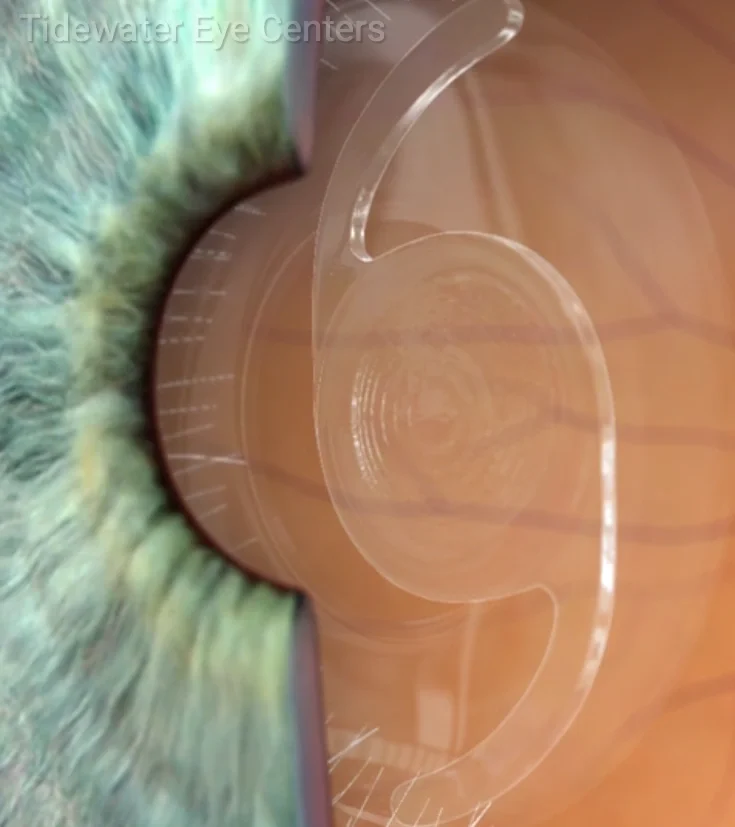
Refractive Lens Exchange (RLE)
At Tidewater Eye Centers, we specialize in helping patients achieve their best vision possible. Refractive Lens Exchange (RLE) is a great solution for many of our patients who wish to reduce their dependence on corrective lenses.
Refractive Lens Exchange in Chesapeake
Refractive lens exchange (RLE) surgery involves replacing the natural lens of the eye with an advanced artificial lens that improves the way the eye refracts light to correct refractive errors. This procedure is identical to the procedure performed to treat cataracts, except that it is performed for elective reasons. Also, because RLE replaces the natural lens of the eye, this procedure prevents a person from developing cataracts in the future. For many of our patients who wish to undergo vision correction surgery but aren’t good candidates for LASIK or PRK, refractive lens exchange could be an ideal solution.

What Does RLE Treat?
Using RLE, our surgeons are able to treat a full range of refractive errors, including:
Presbyopia
Presbyopia is the loss of near vision caused by aging of the eyes’ lenses, commonly begins to affect patients in their 40s or 50s. As we age, the lens becomes increasingly less flexible and more rigid: this prevents the lens from properly flexing to focus on up-close objects. Patients with presbyopia who are tired of depending on reading glasses or bifocals may benefit from RLE.
Nearsightedness
Nearsightedness, or myopia, is a result of a cornea that is excessively steep or an eye that is longer than normal. This causes blurred distance vision.
Farsightedness
Farsightedness, or hyperopia, causes near images to appear blurred because the eye is too short or the cornea is flatter than normal.
Astigmatism
Astigmatism is a result of an irregularly shaped cornea. This causes light to focus on the retina unevenly, leading to blurry vision at all ranges.

Intraocular Lens Options
At Tidewater Eye Centers, we offer a full range of intraocular lens (IOL) options to help our patients achieve their clearest vision possible during refractive lens exchange and cataract surgery. These Lifestyle Lenses can help patients achieve clear vision at multiple distances, making it possible for them to reduce or even eliminate their need for glasses or contacts. Following a detailed eye examination, your eye surgeon will help you decide which type of Lifestyle Lens is best for you.

Who is a Candidate for RLE?
Certain conditions, such as irregular corneas and severe refractive errors, may preclude a patient from undergoing LASIK or PRK, but these patients may still be able to benefit from RLE.
The ideal refractive lens exchange candidate is:
- Over the age of 40
- Not at risk for retinal detachment
- Not a good candidate for other refractive surgery procedures
Refractive Lens Exchange: What to Expect
Preparing for Refractive Lens Exchange
The first step in preparing for refractive lens exchange is to undergo a thorough examination and consultation with an eye surgeon you trust. Once you are approved for the procedure, you will be given clear pre- and post-operative instructions.
Before your RLE procedure, your doctor may ask you to use special drops to prepare your eyes for surgery. You may also be asked not to eat on the day of your surgery. You won’t be able to drive yourself home after the procedure, so you should arrange for a friend or family to help with transportation.
The Refractive Lens Exchange Procedure
Refractive lens exchange is performed on one eye at a time. Before the RLE procedure begins, your eye will be numbed with anesthetic drops and a device is used to hold the eye open and prevent blinking.
To begin the RLE procedure, the surgeon makes a tiny incision in the cornea, breaks up the natural lens of the eye, and gently removes it. Next, an artificial intraocular lens is inserted in its place.
The incision for refractive lens exchange is so small that no sutures will be necessary. You will be fitted with a protective shield over the treated eye, then recover briefly in our eye center before being released to go home.2
Recovery After Refractive Lens Exchange
After your RLE procedure, you will likely want to rest. Be sure to keep the protective shield over your eye any time you sleep for the first few days after your procedure. Also, be very careful not to touch or rub your eye.
You may experience mild discomfort or itching the first few days after your refractive lens exchange surgery. This is normal, and any discomfort will be manageable with over-the-counter pain medication. In the early stages of healing, you may experience vision that is blurry, cloudy, or distorted; this will quickly resolve.
After the day of RLE surgery, we like to leave driving up to our patients’ discretion. You may feel comfortable driving the very next day, or you may feel better waiting a bit longer before driving. You will be able to resume all of your normal daily activities within 48 hours, but please wait at least two weeks before swimming or engaging in high-impact activities.
You should begin to notice a marked improvement in your vision within just a few days of your RLE procedure, though the full results may not be apparent for several weeks as your eye continues to heal.
Convenient Locations in Chesapeake, Portsmouth and Virginia Beach VA
We Look Forward to Seeing You!

805 Battlefield Blvd N #111, Chesapeake, VA 23320
Chesapeake VA, 23320

3235 Academy Ave #201, Portsmouth, VA 23703
Portsmouth VA, 23703

1788 Republic Rd #200, Virginia Beach, VA 23454
Virginia Beach VA, 23454
Contact Tidewater Eye Centers
If you would like to achieve clearer vision but have been told you aren’t a good candidate for LASIK or PRK, you may still be able to benefit from refractive lens exchange. To learn more about all of your vision correction options, please fill out the form below to schedule a consultation with an experienced ophthalmologist.
The doctors at Tidewater Eye Centers have either authored or reviewed the content on this site.